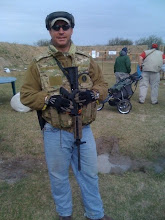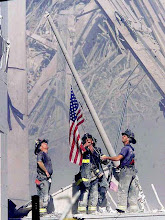I got sidetracked the other day talking about Ham Radio and all the reasons why I enjoy it. This hobby is great because I am constantly learning new things and communicating on a daily basis. It is also a hobby that crosses all socioeconomicopoliticohokeydokey B.S.
Today, I am gonna touch on some of the things to look for in radios. I do this in hopes of steering potential new hams in the right direction. Also, from a SHTF standpoint, you want to make sure your equipment is up to the challenge.
First thing to remember, you NEED to have a license granted by the FCC. Yeah, I know, Tha Man is bringing us down with more registration. SHADDUP! This is just a way to separate the wheat from the chaff. Pay your fee, pass the test and get your license. The Ham License shows that you have shown adequate knowledge and proficiency in amateur radio. Just like getting a CHL, only no gunpowder residue.
Okay, you have your license and a radio catalog in hand. Now what? You must decide what sort of operating set up you need. Based on a couple of factors, this could be easy or hard. Consider what your needs are. Will you be mobile in a car, on foot, or just sitting at home? I happen to be all three. I have a radio in my car, I carry a hand-held on my person, and I have a base station, too.
PORTABLE: Also known as an HT, or handi talkie, a hand-held radio is nice to have when you are out and about. In a large metropolitan area like Houston, you do not have to worry about lack of contact. Repeaters help augment the very limited range of HTs to expand your communication abilitie. From a public safety standpoint, you could ideally reach someone immediately if you got into trouble. This makes it worthwhile rather than having to stop what you're doing, grab your cell phone and dial 911. All that takes time. Picking up the radio and pressing the PTT (push-to-talk) button is instantaneous.
HT radios have limited power. The most you can expect is about 5 watts total output. This drains batteries quickly, but radio manufacturers make radios with several power settings. So you don't drown out other radios, it is a good rule of thumb to transmit on the lowest power setting available. This helps conserve power and prevents interference with other Hams in the area. I usually set up my radios by finding all the local repeaters I can hit with high power, and then switch to low power and try to hit them again. If I can, I will keep that repeater frequency in an active memory bank, if not, I will mask it.
Speaking of memory, you want some. Most radios today come with a lot of memory. My Yaesu VX-7R has something like 450 different memory channels. I have a base memory for all stored freqs. and 9 memory banks I use to keep specific frequencies together, and there are a couple of scan banks and one-touch memories, too. It also has a SW broadcast memory bank and a Marine VHF bank for monitoring. The memory bank should be able to store everything your frequencies need: the frequency, squelch setting, sub-audible tone (CTCSS, DCS, PL), power setting, split and repeater offset. A memory feature that is nice to have but not really required is an alpha-numeric setting. Knowing that you are listening to HPD-TAC 4 instead of the McD's drive-thru is a good thing.
I won't bore you with high tech details. The radio should be rugged and durable. HTs tend to get warm with extensive use, so a metal body as a heat sink would be good. Easy to read display and buttons that don't require a ballpoint pen to push help for those with bad eyes and thick little sausages for fingers. There are a lot of other options and accessories out there for HTs. You should look for the one that will a) fit your budget, b) fit your hand, and c) be easy to operate.
MOBILE: I have a small mobile radio in my truck. It is a Yaesu FT-90. This is a dual band mobile rig with extended receive coverage. What really sold me on this was the size and price. It is a very sturdy rig with easy to use features.
Some features that bear mentioning are a good fan, heat sink, and visible display. As cars have become more modern and streamlined, the interiors have shrunk, too. This leaves very little space for a radio. Used to be that you could mount the whole radio under the dash and be done with it. Removeable faceplates have changed all that. The radio body sits under the front seat and I mounted the face under the dash lip next to the cup holder in my '96 Toyota 4Runner. Works great and is very ergonomical.
Most of the interior features are the same. Big display with an alpha-numeric dot-matrix display helps so I am not distracted when driving. TNC or APRS compatible would be something to consider if you are so inclined. Only Kenwood makes an all inclusive TNC/Packet mobile radio forAPRS and Packet operation.
BASE STATION: You don't get very far away from mobile rigs when you choose a base station. In fact, a mobile rig can serve double duty as a home radio and mobile. All you need is a dedicated power supply and a good antenna. Going a step further, base rigs can have all sorts of bells and whistles to play with. They can be all mode, computer controlled monsters, or they can have the basics to get you on the air.
In today's society, everyone is concerned with looks and appearances. Many of the master planned communities that we are retreating to have deed restrictions and special rules regarding antennas. This limits a ham's ability to effectively communicate. Legislation is pending, but it is a way off. Remember this if you decide to operate from your home and you can probably devise a stealth antenna system that won't piss off the Neighborhood Deed Nazis.
There are a lot of different radios and many different modes for you to operate on. I am just now finding my second wind in Ham Radio. My goal is to get my license upgraded to HF privileges by the end of the year. I am now getting more interested in APRS, too. This is the Automatic Position Reporting System mode of Ham Radio. This was designed by a guy at the Naval Academy several years ago. It incorporates Packet Radio and GPS navigation to pin point a Ham's position. There is a cornucopia of freeware and shareware available and since everyone is getting into GPS, it is pretty affordable to set up.
Find out what works for you. From a public safety/SHTF standpoint, it pays to have all your bases covered. Like a woman in a shoe store, you will want one of each if the ham radio bug really hits you. It is fun and exciting and it adds another level to your state of emergency preparedeness.
Should you need help finding a radio or need advice on getting started, just post a comment and I will return your email. I am always glad to welcome new Hams to the world.
73
It’s the People You Meet Along the Way
9 months ago


1 comment:
Good post. It got me thinking about this topic, and I'm going to have to write something up, get it posted in the next couple of days.
I'm also a ham.
Post a Comment